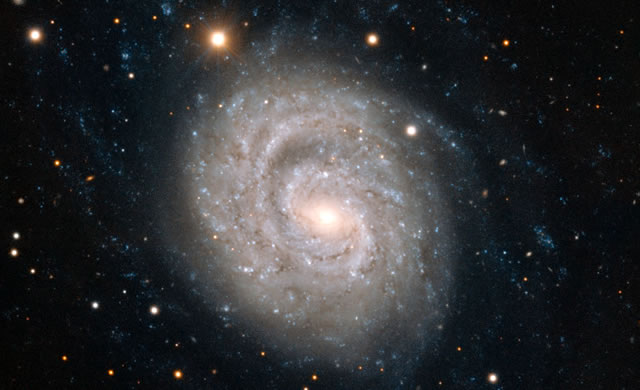
A circa 35 milioni di anni luce dalla Terra, nella costellazione di Eridano, si trova la galassia a spirale NGC 1637. Nel 1999 l’aspetto sereno di questa galassia è stato turbato dalla comparsa di una supernova molto brillante. Gli astronomi che studiano le conseguenze di questa esplosione con il VLT (Very Large Telescope) dell’ESO all’Osservatorio del Paranal in Cile ci hanno fornito un veduta stupenda di questa galassia relativamente vicina.
Le supernove sono tra gli eventi più violenti in natura: rivelano la morte abbagliante delle stelle e possono offuscare la luce combinata dei miliardi di stelle della galassia ospite.Nel 1999 l’Osservatorio Lick in California ha riportato la scoperta di una recente supernova nella galassia a spirale NGC 1637, identificata utilizzando un telescopio costruito appositamente per ricercare questi oggetti cosmici, rari ma importanti. Osservazioni più dettagliate sono state richieste in seguito per confermare la scoperta e studiare meglio l’oggetto. Questa supernova, a cui è stato dato il nome SN 1999em, è stata osservata in più occasioni. Dopo l’esplosione spettacolare nel 1999, la luminosità della supernova è stata seguita attentamente dai ricercatori, che ne hanno constatato la diminuzione relativamente tranquilla negli anni.
Fonte/Leggi tutto → ESO.org
About 35 million light-years from Earth, in the constellation of Eridanus (The River), lies the spiral galaxy NGC 1637. Back in 1999 the serene appearance of this galaxy was shattered by the appearance of a very bright supernova. Astronomers studying the aftermath of this explosion with ESO’s Very Large Telescope at the Paranal Observatory in Chile have provided us with a stunning view of this relatively nearby galaxy.
Supernovae are amongst the most violent events in nature. They mark the dazzling deaths of stars and can outshine the combined light of the billions of stars in their host galaxies. In 1999 the Lick Observatory in California reported the discovery of a new supernova in the spiral galaxy NGC 1637. It was spotted using a telescope that had been specially built to search for these rare, but important cosmic objects. Follow-up observations were requested so that the discovery could be confirmed and studied further. This supernova was widely observed and was given the name SN 1999em. After its spectacular explosion in 1999, the supernova’s brightness has been tracked carefully by scientists, showing its relatively gentle fading through the years.
Source/Continue reading → ESO.org





















